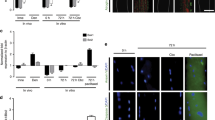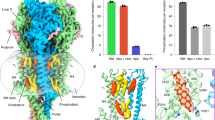Abstract
MYASTHENIA gravis, a disease affecting the human neuromuscular junction, is thought to result from a postsynaptic defect, namely a reduction in the number of functional acetylcholine (ACh) receptors (reviewed in ref. 1). Thus at myasthenic end-plates the spontaneous miniature endplate potentials (m.e.p.ps) and impulse-evoked endplate potentials (e.p.ps) are reduced in amplitude2. Furthermore, the diminished number of α-bungarotoxin binding sites3,4 indicates a reduction in the number of ACh receptors in the postsynaptic membrane which leads to a reduced sensitivity to ACh5; and preliminary experiments with voltage noise (B. Katz, R. M. & J. Newsom-Davis, unpublished) suggested that the decrease in sensitivity does not involve changes in the characteristics of the channels. We have further examined the properties of channels opened by ACh at normal and myasthenic endplates as well as some characteristics of transmitter release in the two conditions. The experiments described here indicate that the single channel conductance and the mean channel life-time are similar in normal and myasthenic muscle membranes but that there are differences in the Ca-dependence of transmitter release from normal and myasthenic nerve terminals.
This is a preview of subscription content, access via your institution
Access options
Subscribe to this journal
Receive 51 print issues and online access
$199.00 per year
only $3.90 per issue
Buy this article
- Purchase on Springer Link
- Instant access to full article PDF
Prices may be subject to local taxes which are calculated during checkout
Similar content being viewed by others
References
Grob, D. (ed.) Myasthenia Gravis Ann. N.Y. Acad. Sci. 274, (1976).
Elmqvist, D., Hofmann, W. W., Kugleberg, J. & Quastel, D. M. J. J. Physiol., Lond. 174, 417–434 (1964).
Fambrough, D. M., Drachman, D. B. & Satyamurti, S. Science 182, 293–295 (1973).
Green, D. P. L., Miledi, R., Perez de la Mora, M. & Vincent, A. Phil. Trans. R. Soc. Lond. B 270, 551–552 (1975).
Albuquerque, E. X., Rash, J. E., Mayer, R. F. & Satterfield, J. R. Exp. Neurol. 51, 536–563 (1976).
Katz, B. & Miledi, R. J. Physiol., Lond. 224, 665–700 (1972).
Green, D. P. L., Miledi, R. & Vincent, A. Proc. R. Soc. Lond. B 189, 57–68 (1975).
Magleby, K. L. & Stevens, C. F. J. Physiol., Lond. 223, 151–171 (1972).
Gage, P. W. & McBurney, R. N. J. Physiol., Lond. 226, 70–94 (1972).
Kordas, M. J. Physiol., Lond. 224, 317–332 (1972).
Katz, B. & Miledi, R. J. Physiol., Lond. 231, 549–574 (1973).
Anderson, C. R. & Stevens, C. F. J. Physiol., Lond. 235, 655–691 (1973).
Hubbard, J. I., Jones, S. F. & Landau, E. M. J. Physiol., Lond. 196, 75–86 (1968).
Cull-Candy, S. G., Lundh, H. & Thesleff, S. J. Physiol., Lond. 260, 177–203 (1976).
Cooke, J. D., Okamoto, K. & Quastel, D. M. J. J. Physiol., Lond. 228, 459–497 (1973).
Coërs, C. & Telerman-Toppet, N. Ann. N.Y. Acad. Sci. 274, 6–19 (1976).
Engel, A. & Santa, T. Ann. N.Y. Acad. Sci. 183, 46–63 (1971).
Ito, Y. et al. Proc. R. Soc. Lond. B 192, 475–480 (1976).
Author information
Authors and Affiliations
Rights and permissions
About this article
Cite this article
CULL-CANDY, S., MILEDI, R. & TRAUTMANN, A. Acetylcholine-induced channels and transmitter release at human endplates. Nature 271, 74–75 (1978). https://doi.org/10.1038/271074a0
Received:
Accepted:
Published:
Issue Date:
DOI: https://doi.org/10.1038/271074a0
This article is cited by
-
Monoclonal antibodies modify acetylcholine-induced ionic channel properties in cultured chick myoballs
The Journal of Membrane Biology (1983)
-
Diffusion of acetylcholine in the synaptic cleft of normal and myasthenia gravis human endplates
Nature (1980)
-
Acetylcholine receptors in organ-cultured human muscle fibres
Nature (1979)
-
Acetylcholine-induced conductance fluctuations in cultured human myotubes
Nature (1978)
Comments
By submitting a comment you agree to abide by our Terms and Community Guidelines. If you find something abusive or that does not comply with our terms or guidelines please flag it as inappropriate.



